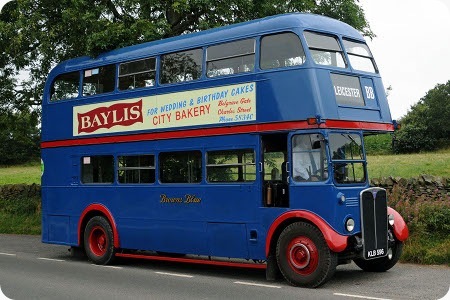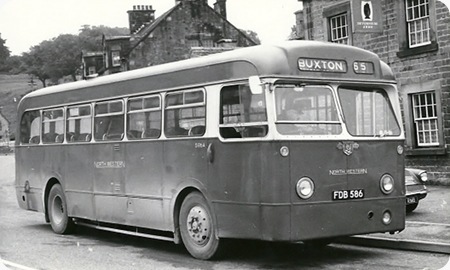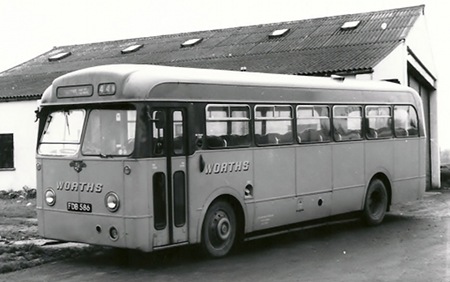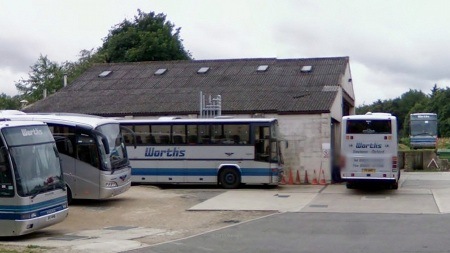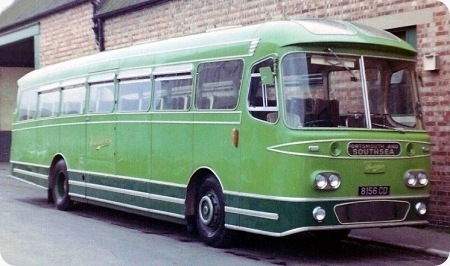
Photograph by ‘unknown’ if you took this photo please go to the copyright page.
Southdown Motor Services
1962
Leyland Leopard PSU3/3RT
Weymann C49F
A few weeks ago this photograph arrived in my inbox with no senders name no e-mail address and not a word of comment. Well as it is a good colour shot of a very nice vehicle and from a southern operator which I would like more of to make the site more balanced I decided to post it.
Checking into the information embedded in the jpg file it states that the shot was taken at the Southdown depot on Hyde Park Road, Portsmouth. Having just been for a drive down Hyde Park Road courtesy of Google street view I don’t think it is there anymore. The Southdown fleet unfortunately did not enter into my spotting days, way out of my area, so only know what most people have read. Anyway I still think it was worth posting, thanks for the shot Mr Anon.
Photograph Mr Anon – Copy Peter
07/08/12 – 14:44
Sorry if I offend anyone, but to me this just doesn’t look right. For my money the fanfare was a classic, but this looks as if one has been been decapitated and repaired in a hurry with whatever could be found lying around, from this angle the back window and the trim under the side ones look very Harrington like, and the end result is neither one thing or another, perhaps a bit more of the darker shade of green above and below the windows and also in the trim on the front may have made a difference. No doubt someone will shoot me down in flames, but that’s just my opinion.
Ronnie Hoye
07/08/12 – 17:40
Was this body style unique to Southdown? Never mind about the shape, just look at the livery – it oozes quality!
Ian Wild
07/08/12 – 17:49
Southdown operated 20 of these PSU3/3RT Leopards with Weymann ‘Castillion’ bodywork. They were delivered in 1962/3. The first 5 were as illustrated, and the final 15 had longer side windows, which improved the appearance somewhat. Not as pretty as the Harrington Cavalier or Grenadier though!

Here is a shot of this superbly restored Harrington bodied example. The bodywork is a short ‘Grenadier’ as opposed to the earlier Cavalier.
This example was delivered in 1964, and was fitted with 28 seats in 2+1 configuration for Southdown’s Coach Cruises.
Roy Nicholson
08/08/12 – 07:23
I have to agree with Ronnie. It doesn’t look right. I have it on one side of my screen as I type this, together with a view of XUF141 taken at Wisley. XUF141 is, clearly, one of the shorter Leopards with Weymann body (Fanfare?) but, to me, this shows definite traces of Harrington. Hybrid, anyone???
Pete Davies
08/08/12 – 07:24
This is a Grenadier 3110 with a Cavalier front.
Philip Lamb
08/08/12 – 07:25
I see Ronnie’s point of view but the design does have some character and certainly looks a solid job. It seems to me that the front line bus body builders never seemed to quite hit it off when moving to building coaches. They always ended up with a dual-purpose look about them, like a ‘flashy’ bus. The Weymann Fanfare was an exception but does anyone remember those unhappy efforts East Lancs made at building coaches for Accrington and Widnes. At least they had the good grace to stick to buses after that!
Philip Halstead
08/08/12 – 07:26
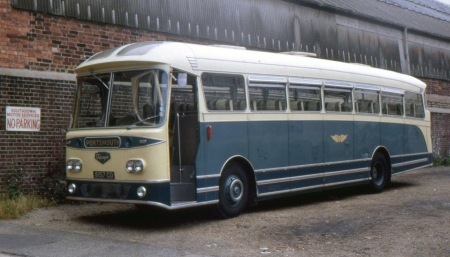
Although the photo of 1156 was not my submission, I thought you might like sight of 1157, another of the same batch, but this time in the livery of Southdown subsidiary Triumph Coaches.
I took the photo in July 1967, on the parking area adjacent to Southdown’s Hyde Park Road, Portsmouth premises.
Bob Gell
08/08/12 – 07:27
Ronnie,
Yes, you’ve guessed – I like it. Beauty is in the eye of the beholder – which is why I guess Southdown purchased them . . . unless Weymann offered a cheaper "look-a-like-Harrington-style" than Harrington could offer. Those windscreens look identical to those on Bradford’s 256-270/286-300 batches of MCW-bodied Atlanteans (and "Manchester"-style bodies elsewhere?). Anyway, I prefer the smooth roof-line of the "Castllian" to the stepped roof-line of the Harrington offering, which . . .
Roy
Has a Cavalier front panel . . . why? Why not just produce a short Grenadier, full stop?? Did Southdown request this bastardisation, and why??? Perhaps because it looks better . . .
Philip Rushworth
08/08/12 – 08:46
Philip,
All of Southdown’s Grenadier’s had Cavalier front panels, so I suspect it was a matter of standardisation. Southdown were renowned for specifying follow on batches in similar body styles to previous batches……….Probably to disguise the age of older vehicles before the days of ‘Paddy plates’
Roy Nicholson
08/08/12 – 08:47
First an apology for the fact that the photo arrived without the text, at the time I was having a self inflicted problem connecting the two.
In answer to the comments made yes these vehicles were unique to Southdown and the second batch of 15 No’s 1160-1174 with the longer side windows did look infinitely better sleeker and more elegant (a personal view I know) this batch also lacked the perspex lights in the front dome which tidied up the looks.
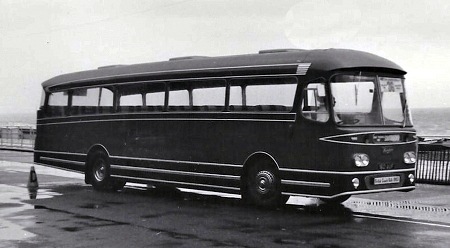
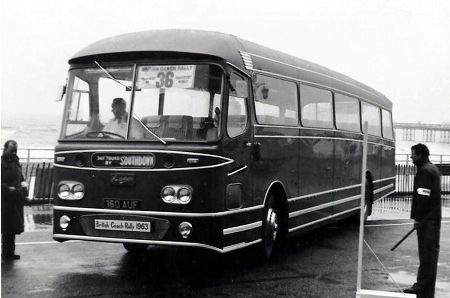
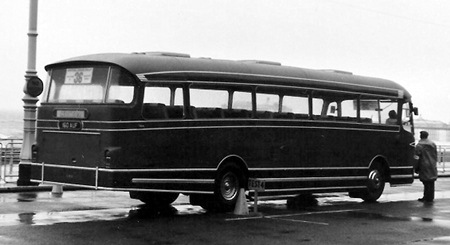
Here are some B/W photos of 1160 at a very wet 1963 Brighton coach rally, this particular vehicle was also on the Weymann stand at the 1962 Earls Court show.
Regarding Hyde Park Road the name was changed in the early 70’s to Winston Churchill Avenue and the depot name changed at the same time
Diesel Dave
08/08/12 – 15:08
A lovely batch of photos for me to enjoy, especially the Triumph one, which bring back Southsea memories. Certainly the later ones with fewer windows look sleeker.
Chris Hebbron
09/08/12 – 07:13
Are there any photos of the Accrington or Widnes coaches mentioned above?
Jim Hepburn
09/08/12 – 07:14
Apologies to Pete Davies for being picky but XUF 141 No 1141 like all Southdown’s Fanfares was on a Tiger Cub chassis. As Philip says the Castillians look a solid job and indeed they were just that and very pleasant coaches to drive, I drove for Southdown from 1969-91 at Eastbourne depot where at different times we had No’s 1160/61/62/65 all of which were among the six with only 45 seats which were low backed and leather covered in two tone green the rest were 49 seaters, 1156-59 the short window batch had high backed moquette covered similar to the Fanfares so were not as light and airy inside. These coaches looked and drove very much better than the following batches of Plaxton bodies.
Diesel Dave
09/08/12 – 07:14
Following the demise of Southdown’s favoured coachbuilder Beadle, the company switched allegiance to Weymann acquiring 35 Fanfare-bodied Leyland Tiger Cubs, bringing it more into line with contemporary BET preferences. The arrival, however, of the more powerful L2 Leopard and the availability of Harrington’s Cavalier prompted Southdown to renew its ageing coach cruise fleet with a batch of 43 vehicles of this combination in 1961/62, supplemented by a pair of Cavalier-bodied PSU3/3RT 36-footers. The same year saw the arrival of the initial five Castillians (clearly a relative of the Fanfare), also on PSU3/3RT chassis, of which three were allocated to Triumph, entered service the same year. These five coaches are sometimes wrongly described as 36ft-long Fanfares. That particular animal was never built, and if it had have been, would have looked quite different. A Fanfare stretched to 34ft and heightened to 11ft 9in was built on an LHD Worldmaster chassis in 1956 as an export demonstrator. No orders were received and the sole example, given the name Arcadian, was exported to Spain. What is more interesting about this coach is that it featured three ‘panoramic’ side windows with no ventilators — two years before the arrival of Plaxton’s Panorama! The Castillian, on the other hand, in both short- and long-window form was in the main a new design. It only found favour with Southdown probably as a follow on to its Fanfare fleet, The 15 long-window Castillians, which I agree make for a better looking coach, were also improved by their lack of ventilators, and would have looked even better in Triumph colours . . .
Philip Lamb
09/08/12 – 11:19
No offence taken, Dave! I’ve amended my records. Southdown is a foreign fleet to me . . .
Pete Davies
09/08/12 – 18:17
Granted the later version with the larger windows does look better, but it still looks like a racehorse designed by a committee. Harrington? yes – Weymann? yes but not a hybrid of the two.
Ronnie Hoye
09/08/12 – 18:18
Jim,
You’ll find a Widnes example at www.flickr.com/photos/
Mike Grant
11/08/12 – 07:09
Been away for a while, hence my silence. Back to quality over appearance – which is why Southdown probably bought them. I agree, generally, with others. I am a Fanfare fan and think the later long windowed Castillians work better.
Shortly after, Weymanns closed down and all production went to Birmingham and the newly formed MCW. Now the Topaz really was a visual dog. The later "Metropolitan" coaches were a little better – but only available on Fords and Bedfords. Some were sub-contracted to Strachans. Am I right in thinking that Starchans also produced some Orions? On sub-contract?
David Oldfield
11/08/12 – 12:02
Nice to see you’re back, David, and that you remain concentrated on the quality/performance/appearance theme. Keep watching, ‘cos your sharp and informed observations, (especially about AEC), are always worth reading.
It may be that quality influenced Southdown, but with due respect to Weymann, I can’t think that could have been a determining factor in a comparison with, say, Harrington. Nor, I suspect, would price, because although price was important, Southdown depreciated their fleet over 12 years, which minimised the effect of small price differences. Availability may have ben a factor, but it may just have been a matter of preference – beauty in the eye of the beholder again. Southdown’s choice of Queen Mary double-deckers, which many enthusiasts admire greatly, was not all that popular elsewhere. It was largely a matter of consistent overall fleet image as perceived by top management.
I found Diesel Dave’s driving experiences interesting, too. I never drove a Southdown Plaxton – only a Castillian, which, (you may like this, David), I didn’t think was a patch on M&D’s Reliances.
Roy Burke
12/08/12 – 07:13
Thanks for your kind comments Roy but, including yourself, I am by no means the only expert on this forum. There are no doubt many others who could claim that laurel. Your observations are equally on target.
A few observations. The Cavalier was a big improvement on its predecessor, possibly, therefore a holding pattern before the arrival of the Cavalier. ….. also, were they comparing metal frames on the Weymann bodies with composite on the Harrington? Finally, the rear end of the Castillian still looks like a rip off of the Cavalier – so which did, indeed, come first?
David Oldfield
19/03/13 – 07:20
Sometime in the early 1970s Hyde Park Road in Portsmouth was remodelled with some of it being renamed Winston Churchill Avenue. I was working at Yelloway at the time and, through our joint operator Associated Motorways (of which Southdown was a member), we were asked to include an extra note in the timetable for the Rochdale-Portsmouth/Southsea service for a couple of seasons which read something like ‘Winston Churchill Avenue Coach Station was previously known as Hyde Park Road Coach Station’. I called there once when passing through on holiday and I have a vague recollection of the coach station building standing all alone in quite a wide open space of redevelopment.
David Slater
19/03/13 – 11:46
You’re quite right, David, but calling it a coach station was stretching the imagination! It was a nondescript depot building with a storage yard and lots of bombsite land around it on which to park all the vehicles. The depot was not mentioned on blinds, merely ‘PORTSMOUTH – HYDE PARK ROAD’. Summertime, Southdown/Triumph coaches were stored there ready for the seafront tours.
Chris Hebbron
21/03/13 – 10:55
I can well imagine the poor state of the property Chris! Regarding the location. A comment on Flickr from ‘PD3’, a person who has taken lots of photos of Southdown vehicles including some Harrington Cavaliers parked around the Hyde Park Road garage, reads ‘The [Ibis] Hotel would have been next door to where the depot was, the land now has a building used by Portsmouth University upon it’.
Some of his photos at Hyde Park Road, which feature buildings in the background, include: //www.flickr.com/photos/one
Without realising it, I already had a photo on Flickr of the timetable for the Summer 1973 joint Yelloway/Associated Motorways Rochdale-Portsmouth/Southsea service which features the statement ‘Winston Churchill Avenue Coach Station was previously known as Hyde Park Road Coach Station’ //www.flickr.com/photos/two
David Slater
02/02/14 – 16:21
With regard to Chris Hebbron’s comment about Southdown/Triumph coaches being parked at Hyde Park Rd ready for Excursions, that is not really correct as the Triumph fleet was permanently based there, including the 3 Weymann-bodied Leopards. Had you visited on a Saturday/Sunday you would have found very few coaches there as they were either in the North (mainly) of England having worked Forces leave services on Friday evening, returning overnight on Sunday. While away from Portsmouth, they worked on the Saturday for local operators, so that fore example a coach working to Leeds on Friday would then be ‘on hire’ to West Yorkshire and work from Leeds to Scarborough or perhaps Morecambe on the Saturday.
Paul Statham
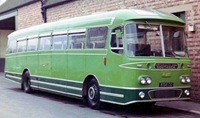 Vehicle reminder shot for this posting
Vehicle reminder shot for this posting
31/08/17 – 05:00
One thing one has to admit about the Harrington bodies was that they remained rattle free long after others had deteriorated. 1750, shown above, was most famous for being ‘The Albion Car’, piloted by Bert ‘Crasher’ Mills for the Brighton football team.
Having renamed Hyde Park Road in the early ’70s, I well remember an indignant patriot sending in a complaint to Southdown House in Brighton. All that could be squeezed into the destination box was ‘Portsmouth W C’hill Ave’ and our complainant was incensed that our wartime leader had been reduced to ‘W C’hill’.
Nick Turner
